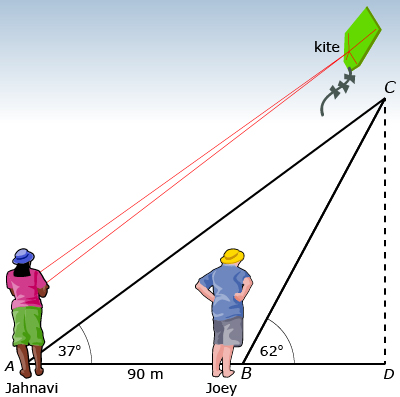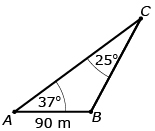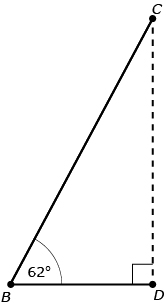Lesson 4
1. Lesson 4
1.4. Explore
Module 1: Trigonometry
Explore
In this lesson you will use your experience to determine whether to use the sine law or the cosine law to solve problems that require more than one triangle. Problems may include right triangles, oblique triangles, or both.
The first problem in the Focus section will now be revisited.
Example 1
Joey is flying a kite and wants to determine its height. He enlists the help of his friend, Jahnavi, who is standing 90 m away. Joey uses a clinometer and determines that the angle of elevation to the kite is 62°. Jahnavi determines that the angle of elevation is 37°. To keep calculations simple for this question, ignore Joey’s height and assume that the kite string touches the ground.
Jahnavi starts by drawing the following diagram.

After drawing the picture, Jahnavi realized there are three triangles in this diagram: ![]() ,
, ![]() , and
, and ![]() . Since
. Since ![]() and
and ![]() share side BC, she decided to use a three-step approach:
share side BC, she decided to use a three-step approach:
Step 1: She will use her knowledge of straight angles and sums of angles in triangles to determine ∠ABC and ∠ACB.
Step 2: Use ![]() to determine the length of BC.
to determine the length of BC.
Step 3: Use ![]() to determine the height (CD).
to determine the height (CD).
|
Step 1 of Jahnavi’s Solution |
|
|
∠ABC + 62° = 180°
∠ABC = 118° |
Straight angles add to 180°. |
|
37° + 118° + ∠ACB = 180°
∠ACB = 25° |
The sum of the angles in any triangle is 180°. |
|
Step 2 of Jahnavi’s Solution |
|
|
|
|
|
|
Jahnavi multiplied both sides of the equation by sin 37° in order to isolate BC. |
|
BC = 128.1614… |
Jahnavi has not rounded this number because it is not the final answer. |
|
Step 3 of Jahnavi’s Solution |
|
|
|
|
|
CD = (128.1614… sin 62° |
Multiply both sides of the previous equation by 128.1614… |
|
CD = 113.1598 m |
The unrounded value of CD is 113.1598 m. |
|
CD = 113.2 m |
The kite is 113.2 m above the ground. |

